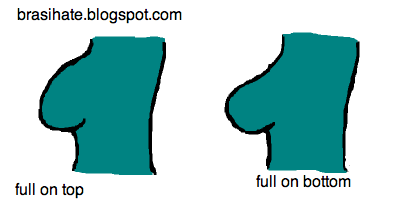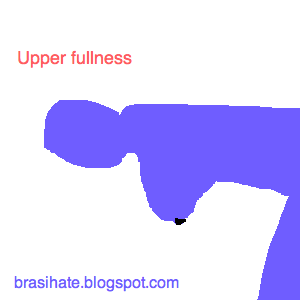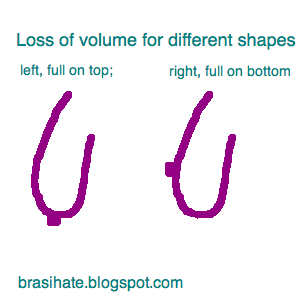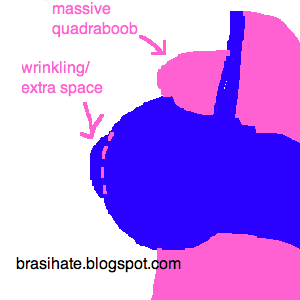We've all been there--you buy a bra, it's not the best, but you
miss the return date. So you wear it occasionally, or maybe it just sits and
gathers dust. Or maybe you have a ton of bras in your size and suddenly your
size changes. Investing so much money into bras you can't wear can put a
serious dent in your budget. The best way to deal with this is to re-sell your
old unworn or unwearable bras! In the past year or so, I've made a solid
effort to sell off all the bras I don't wear often enough or don't love enough
to keep. I just mailed off the last one today and now I'm full of wisdom on the
process, so I thought I'd share it with my readers. Selling bras gets much
easier over time, even though it can be daunting at first. You can sell through
eBay, Bratabase, or forums. I spent the first 90% of my selling spree using
forums to sell bras, and then recently began listing through Bratabase. In my
experience, listing through Bratabase leads to much faster sales, but you can
use whatever medium you are comfortable with to sell, as long as you make sure
to protect yourself (which I'll discuss at the end of this post). Here are my
tips for successful bra selling.
1. Know the market value of the bra you are aiming to sell.
Check ebay and websites that have sales (Figleaves, Brastop). If you’re selling
a bra that is very widely available at bargain prices, you are not going to get the original full retail price for it even if it’s new. Used bras are, of course, worth less
than bras that are new with tags, but if a used bra is in great condition, you
can still get a good price for it, especially if it's a hard to find model. I just sold my gently used Freya Antoinettes
for $12 each. That bra is generally available new for about $20 on eBay, so that dictated my
lower price. I also just sold my gently used Thea for $25. That bra isn’t
available anywhere—the color was never sold online, and the yellow is being
sold for £24 on Bravissimo’s website now—so I was able to fairly ask for a higher
price because it’s a harder bra to find. Bras that are no longer available
might get you a higher price than ones that can be found easily on eBay, but
think more in terms of a mid-range price.
Used bras vary in value depending on their condition. Barring any damage from use, you can determine the bra's quality (how heavily used it is) from the tag. If the tag is gray or faded,
frayed with loads of threads coming off, or the text is blurred and illegible, you have a heavily used bra on your hands and
you should ask for a lower price ($5-$15 range). If the tag looks as clean and
neat as when you bought the bra, you have a gently used bra and can ask for
more ($15-$25 or possibly more for high-demand bras like Ewa Michalak). If a
bra is brand new with tags, you can ask for more ($30-$45), but keep in mind
that you still need to ask for less than a retailer would ask. In general,
people will still prefer to buy from a trusted retailer over a random internet
stranger, so you have to offer a lower price (or at least lower shipping) to
convince people to buy from you.
2. Apart from its market value, understand the value of the bra TO YOU. Think about what it is
worth to you to own the bra. Would you happily part with it for $20? Would you
happily part with it for $10? Do you just want to get rid of it? Does it have
enough sentimental value that you’d need to get $25 or more to even consider
selling? Compare the bra’s value TO YOU to the market value. If its value to
you is much higher than the market value, then it’s not worth it to sell. Keep
the bra—you’ll just feel disappointed by what you get for selling it. If the
value to you is lower than the market value—ask the market value! Don’t sell
yourself short just because you’re not attached to a bra—sell it for what it is
properly worth. And don’t expect that if you put a bra on eBay with a starting
bid of $0.99, that it will magically reach the exact value you want it to. I
wouldn’t recommend letting people bid unless you don’t care about the price you
get. I’d recommend Buy It Now or a starting bid of just under the bra’s market
price.
3. Be careful with bargaining. If you are selling on Bratabase
or in a forum, you may find that people will try to bargain you down to get a
lower price. To a certain extent, this is perfectly reasonably. For instance, I
recently gave someone a few dollars off on a bra because that made the difference
between her buying it and not buying it. I still got a good value and the buyer was very polite about it. However, sometimes people will offer
you prices that are downright insulting. These people do not respect you and
are just trying to take advantage of your kindness to get a price far below
what the item is worth. You do NOT have any obligation to bargain with people.
If you know the accurate market value of the bra and its value to you, and you
are asking a fair price based on that, you are perfectly within your rights to say “Sorry, I
am asking a fair price and I don’t bargain.” I once sold a basque that I had
bought for $75 new for $15 because a rude buyer pressured me and I was too shy
to say no. It was worth $35 lightly used and the incident still haunts me.
4. Name a price—don’t just ask for offers. If you post items for
sale with no asking price and just tell people to give you their best offer,
then you will lose a LOT of potential buyers. I personally will NEVER make an offer on an
item that doesn’t have a starting price because I don’t want to risk being rude
by accidentally offering too little, and I don’t want to feel embarrassed if I
get turned down; I also won’t know if I am offering much too much for what they
were hoping for. Shy buyers like me won’t touch your items if you don’t name a
price because we just don’t want to open that can of worms. On the other hand,
people who do make offers will often make offers far below what you were hoping
to get, and you will be forced to ask for more or simply turn them down. Do a
little research, find out the market value of your item, and make it clear what
price you would like to get. You will nearly never lose potential buyers by doing
this.
5.
Make sure you wash the item before you list it for sale. By
doing this, you will be able to see the true quality of an item. Sometimes
there will be marks and stains on a bra that go away with a simple wash and the
condition will be much improved. Other times, marks will not go away and you
will NEED to know this before listing it so you can ask for the true (in this case, lower) value.
6.
Do a little basic maintenance on the bra beyond just
washing it. Many bras will pick up pills from sweaters or tops they come in
contact with. These can easily be trimmed off. Just gently pull the pill away
from the bra and snip it off with scissors. You’ll often find these pills on
the straps of Freya bras or the bands of Panache bras. Freya bras sometimes
grow a bit of fluff on the lining underneath the band. This, too, can be
carefully trimmed off to make the bra look nicer. If you’ve altered the bra at
all, it can usually be taken out without damaging the bra. Carefully snip the
stitches out and make sure there are no marks left. There is a lot you can do
to improve the quality of a bra to make sure that potential buyers will find it
up to par. That being said, though…
7.
Always be honest about the condition of a bra. If there are
any stains, marks, tiny holes, snags, etc, describe them in detail and
photograph them. Most buyers will not be upset or put off by such issues as
long as they KNOW ABOUT THEM before they commit to a purchase.
8. Charge for shipping, too, unless you're shipping through Bratabase. If you use Bratabase, you will just charge the buyer the cost of the bra and pay the shipping yourself. Then Bratabase will pay back your shipping up to $10 per bra if you transfer the bra to the buyer and fill out a feedback form containing the shipping amount and your Paypal address. But if you're not using Bratabase, it's a good idea to know what the shipping will be before you deal with payment so you can do it all at once. In my experience shipping from the Eastern USA, shipping a bra typically costs $3 to elsewhere in the US ($5 for multiple bras or a larger molded bra) and $7 to the UK or Europe. Canada once cost me $8.50 for two bras, and Australia is usually about $7, but sometimes up to $9 for padded/molded. So I typically charge those prices if I'm selling on a forum, because I used recycled packaging. If you need to buy new packaging, you'll need to charge about $1-$2 more.
So what if you sell a bra? You will now need to deal with payment and shipping.
Always use Paypal to protect yourself. The whole point of Paypal is that strangers on the internet can safely exchange payments without revealing their private financial information. Paypal also includes many protections for both seller and buyer.
Before I began selling bras, I had no idea how to use Paypal outside of eBay, but it is actually very easy. There are two options: either the seller sends the buyer an invoice, or the buyer sends the seller a payment. There are some minimal fees (usually like $0.30, at most a few dollars) for receiving payments, but keep in mind that these small fees buy you all the protections that Paypal offers.
To send an invoice to your buyer, find out their email address. They do NOT need to have a Paypal account for this to work--all they need is a credit card. Log into your own Paypal account and click "Request money." Enter their email address and the amount. Boom--easy. The buyer will receive an email that will tell them how to pay either through their Paypal account or with a credit/debit card.
If they want to send a payment to you, give them the email address associated with your Paypal account (if you don't have one, make one). They will have to send this through their own Paypal account, so if the buyer doesn't have a Paypal account, you'll be better off sending them an invoice through your own account.
Once the payment is complete, the next step is mailing off the bra. I usually send unpadded bras in one of those soft "tough sac" mailers--the same thing bras get mailed to me in. You can also use a padded envelope or a small box, but the bag-type mailers tend to weigh a little less and be cheaper. I mostly use whatever packaging I have around at home. If you're re-using packaging, make sure to gently remove or carefully cover up (by taping paper onto them) any old labels and barcodes. Make sure the address and return address are clearly legible. I think it's generally a good idea to protect the address, either by covering it fully in postal tape, or by covering it with a piece cut from a clear zip-lock bag and taping around that. The post office doesn't require that you do this, though. If you're mailing a molded bra, make sure to add some padding (tissue paper is nice, but old grocery bags work just as well as long as they are clean and dry). This will help it keep its shape and avoid any damage during mailing.
Once you're ready to mail the package, it's time to deal with the post office! If you're anything like me, going to the post office can be a bit of a harrowing experience until you're used to it. It helps to go in with plenty of time before they close and be prepared to potentially wait in line for a bit.
If you are mailing something internationally, you will have to fill out a customs form. Don't despair--it is easier than it sounds. If you're totally lost, just ask the people working there for assistance. But the customs forms are all available at the tables that you can write on before getting in line, and it speeds things up to fill them out before you get to the front of the line. For those in the US, you will need to fill out the form PS 2976--it will say "USPS Customs Declaration CN-22" or "Sender's Declaration" on the top. You'll need to fill out your own address, the address you are mailing to, and what you are mailing. Check off "merchandise" or "gift", then list the item ("lingerie" or "clothing" both work) and its value (what the seller paid you for it). There are instructions for doing this on the first page of the form. You will also want to check off the "exception" for your package being under a certain very high value, as instructed. (The form only includes two options for exceptions and you will check off the first one). You don't need to write down the item's weight--the post office will weigh it and do that for you. Then sign and date the form. When you get to the front desk, you can ask them if everything is correct if you are nervous about it. Don't over-think it--like most bureaucratic forms, the customs declaration looks a lot more complicated than it is. They will tell you if you need to add something else to it.
What about insurance and tracking? It is up to you and your buyer to decide whether it's worth paying more for tracking. If you have tracking and/or insurance, you will be protected against both postal error and the buyer potentially claiming to have never received the package even if they did. But it can also be very expensive. I personally find that it is worth it to get tracking for an order within the US (it costs only $0.90 extra) but not so much for something you're shipping overseas. I personally trust the postal service not to lose my items, and I only ship to buyers that seem trustworthy, but I also accept that this philosophy might occasionally lead to me losing some money. For me, that's okay, but if you're not okay with that, then you should definitely only ship with insurance and tracking for peace of mind. Just let your buyer know upfront that you only ship that way so they will be prepared to pay more.
Well--that's all the tips I have for re-selling and mailing bras! Any questions, or tips I missed? Let me know in the comments! And many thanks to all those who have bought my bras through Bratabase in the past few weeks :)











